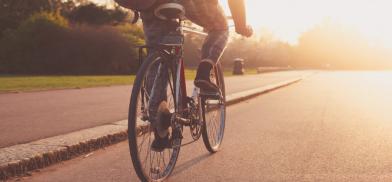Needed a bicycle renaissance to promote environment-friendly road culture
From lockdown, we learned that there is a big opportunity for cities to support non-motorised transport to achieve sustainable cities and a non-polluting environment, writes George Cheriyan & Amar Deep Singh for South Asia Monitor

Due to restrictions of vehicle movements during the lockdown, in the last few months, the pollution level in cities across the world drastically reduced, which triggered discussions regarding lockdown to be the effective option for controlling air pollution. Many European cities saw significant rise in nitrogen dioxide compared with what was witnessed during the lockdown, according to data of the European Environment Agency (EEA). The media reported a 79 percent decline in air pollution in Delhi during the lockdown. But after opening up, pollution started rising again.
People in cities with high levels of air pollution were adversely affected due to the pandemic. Global and national data underscore the environmental benefits of lockdown have been short-lived, as more commuters shun public transport, due to fear of the virus and used their own cars, or public transport is not back in operation yet in many cities. The pandemic provided an opportunity to rethink about sustainable modes of mobility, which is less polluting and healthy for living.
Bicycle - sustainable mobility mode in Asia
Bicycle is one of the most sustainable modes of transportation. More Asians are jumping on a bicycle for fresh air and to lead a more environmentally-friendly and active lifestyle. It has several benefits as it requires zero dependencies on fossil fuel, zero emission of carbon, health benefits from increased physical activities. During the lockdown, there was a drastic increase in the number of people using bicycles. It is also the best choice of transportation for low-income households.
According to a Pew survey, 78 percent of households in Japan are bicycle owners, the second-highest in the world after Germany. In China, 65 percent have a bicycle. Taiwan, one of the world’s biggest manufacturers of bicycles, is bidding to become Asia’s cycling hub and is proving that bicycles could be a major sustainability driver. It prides itself as the only country in Asia, which has strategically established a national network of bike lanes, stretching 4,017 km in 2014, and attracting cycling enthusiasts worldwide to explore the island nation’s nature hotspots.
In South Asia, bicycle is a viable solution for an ordinary Pakistani worker, which can create labour mobility. An estimated 12 million bicycles are sold each year in India and the last census in 2011 showed that 45 percent of Indian households own a bicycle. However, this percentage is reducing very fast, though in recent months bicycle sales have shown a welcome increase.
Non-motorised green transport
Sustainable transport provides a critical enabling environment to support economic and social development necessary to achieve the Sustainable Development Goals (SDGs). For example, transport is a primary consumer of fossil-fuel energy, so it is critical to the achievement of SDG7 on energy. Likewise, transportation is indispensable to achieving SDG9 which is building resilient infrastructure and SDG11 on sustainable cities and communities, realized through improvements in road safety and by expanding public transportation. There is also a strong linkage between transport activity and economic development.
Cycling is and has been, a major mode of mobility in India mainly for poor, and hobby or exercise for rich people. During the lockdown roads became empty, and common people in most cities switched to cycles as an easy mode of transport. In the absence of public transport, several migrants in India used bicycles to reach their home town during the lockdown. Jyoti Kumari became famous as she cycled 1200 km with her father from Gurgaon to reach their native village in Bihar. Ivanka Trump, daughter of US President praised Jyoti’s cycle story and appreciated India’s cycle enthusiasm.
Public Bicycle Sharing
Cycling is difficult on terrible traffic of the city, which is a danger to life, in the absence of a dedicated cycle track. According to road accident data of India, cyclists and pedestrians are vulnerable on road. Proper infrastructure with a separate track for non-motorised vehicles needs to be constructed, where other motorised vehicles should not enter. The main constraint in these schemes taking off is lack of political will and policy support.
Indian cities developing high quality of transport systems that provide sustainable mobility to their residents is reflected in the National Urban Transport Policy of India, that says cities should have moving people, not vehicles. Public Bicycle Sharing (PBS) is seen as a scheme, which can provide first and last-mile connectivity to the people and it can also improve the image of cycling in Indian cities. Smart City Mission in India is supporting to create adequate infrastructure with cycle-friendly roads and allocating cycle-docking stations in different areas of the city.
Eventually, we need to adopt a lifestyle, which is sustainable and not harmful to the environment and natural resources. From lockdown, we learned that there is a big opportunity for cities to continue support of non-motorised transport to achieve sustainable cities and a non-polluted environment. As we all have a childhood cycle story, let the new generation in India and South Asia adopt a cycle and continue to engage them by providing good infrastructure that is safe. We have the opportunity to promote a people- and environment-friendly road culture.
(The writers work with CUTS International, global public policy research and advocacy group. The views expressed are personal)









Post a Comment